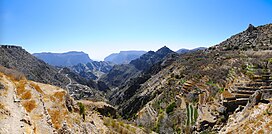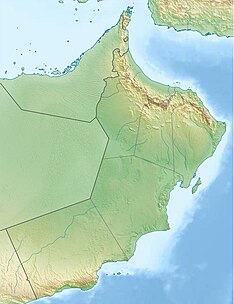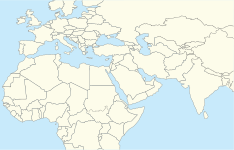Jebel Akhdar (Oman)
| Jebel Akhdar Mountains | |
|---|---|
 Terracesin Jebel Akhdar, 2011 | |
| Highest point | |
| Elevation | 3,018 m (9,902 ft)[1] |
| Coordinates | 23°06′N57°24′E/ 23.1°N 57.4°E |
| Naming | |
| Native name | Al-Jabal Al-Akhḍar (ٱلْجَبَل ٱلْأَخْضَر(Arabic)) |
| Geography | |
| Location | |
| Parent range | Al-Hajar Mountains |
TheJebel Akhdar Mountains(Arabic:ٱلْجَبَل ٱلْأَخْضَر,romanized:Al-Jabal Al-Akhḍar,lit. 'The Green Mountain') is amountain rangeapproximately 80 km (50 mi) long and 32 km (20 mi) wide,[2]that is partHajar MountainsinAd Dakhiliyah GovernorateofOman.
It rises to a height of 3,018 m (9,902 ft)[1][3]and encompasses the Saiq Plateau at 2,000 m (6,600 ft) above sea level.
Jebel Akhdar Mountains is famous for its labyrinth ofwadis(river valleys) and terraced orchards, where pomegranates, apricots, and roses grow in abundance due to its mild Mediterranean climate.
The highest peak in the Jebel Akhdar Mountains isJebel Shams,[4]which with its elevation of 3,018 m (9,902 ft) is also the highest peak in theHajar rangeand inOman.[1]
Jebel Shams also has a second summit (the South Summit), which is publicly accessible for trekking via the W4 Trail.[5]The elevation of the second south summit is 2,997 m (9,833 ft).[5]
Geology and geography
[edit]This mostlylimestone[6]mountain is one of the highest points in Oman andeastern Arabia.Jebel Akhdar lies at the central section of the Hajar range, located around 150 km (93 mi) fromMuscatand accessible only by four-wheel drive.[7]The range is mostlydesert,but at higher altitudes receives around 300 mm (12 in) ofprecipitationannually — moist enough to allow the growth ofshrubsandtreesand supportagriculture.[8]It is this that gives the mountains their "green" name.[9][10]
An old stronghold on the inland side of the mountain isBirkat al-Mawz,or Pool of the Plantains, with a layout similar to the nearbyJabrinpalace.[11]
"Poised across the yawning mouth of a great pass into the mountains, Birkat al-Mawz was one of the fortresses of the Bani Riyam tribe which controlled the mountain heartland. Collapsing into ruin until recently, the mud-brick fortress and its painted ceilings are now well on the way to restoration."
— Aramco World.
The area is about a 45-minute drive fromNizwaand is known for its traditionalrose waterextraction[12][13]and agricultural products includingpomegranates,walnuts,apricots,blackgrapes,andpeaches.It is also the site ofhoney beebreeding for much of Oman.[14]Agricultural production is improved by the use ofFalajirrigation channels and their associated terraces system devised by the local farmers, who have lived on this mountain for hundreds of years.Al Sogarais a historic village carved into the mountainside.[15]The Jebel is mostly inhabited by the ancientArabtribe Bani Riyam (al Riyamy).[16]Most descendants of the tribe are now in the four nearby villages, including Nizwa,IzkiandIbra.[17]
Ecology
[edit]Jebel Akhdar Mountains is inAl Hajar montane woodlandsecoregion. The plant communities on the mountain vary with elevation. Shrublands and dry grasslands are found from 450 to 1,300 meters elevation. The grasses and shrubs are adapted to arid conditions, and include many drought-deciduous and succulent plants. Typical shrubs includeConvolvulus acanthocladus,Euphorbia larica,Grewia tenaxsubsp.makranica,Jaubertia aucheri,Maerua crassifolia,Moringa peregrina,andPseudogaillonia hymenostephana.[18]
Semi-evergreen woodlands ofsclerophylloustrees are found between 1,350 and 2,350 meters elevation. Common trees and shrubs includeSideroxylon mascatense,Dodonaea viscosa,Olive(Olea europaea),Ebenus stellatus,Grewia villosa,Juniperus seravschanica,Myrtus communis,andSageretia spiciflora.[18]
Above 2300 meters elevation, open woodlands of juniper (Juniperus seravschanica) predominate, with the shrubsCotoneaster nummularius,Daphne mucronata,Ephedra pachyclada,Euryops arabicus,Lonicera aucheri,Periploca aphylla,andSageretia spiciflora.[18]
Farming
[edit]The mountain is a traditional farming area, with mountain springs providing sufficient for irrigation needs. However,climate changehas reduced annual rainfall and increased nighttime temperatures.[19]
History
[edit]Between 1954 and 1959, the area became a site of theJebel Akhdar War,a conflict betweenOmani forcesloyal to thesultan of Oman(aided by British soldiers, including theSpecial Air Service) andSaudi Arabian-backed rebel forces of the inlandImamate of Oman.[20]
In August 2011,Sultan Qaboosdesignated Jebel Akhdar anature reservein a bid to conserve its unique yet fragile biodiversity. A decree issued by Sultan Qaboos established the 'Jebel Akhdar Sanctuary for Natural Sceneries'. The Minister of Environment and Climate Affairs has authority to draft guidelines regulating access and developmental activity within the reserve.[21]
Since 2011, the mountain has featured as the principal climb in theTour of Omanroad bicycle race.[22]In the area, several important rock art sites, with figures dating back to 6,000 years ago, have been discovered and studied.[23]
See also
[edit]References
[edit]- ^abcpeakbagger - Jebel Shams, Oman
- ^https:// agda.ae/en/catalogue/tna/air/5/1284/n/39Persian Gulf and Arabian Coast: mountains or mounds - Ref. AIR 5/1284 - PAGE 39 - The National Archives, London, England
- ^"Mountains in Oman".Ministry of Tourism, Sultanate of Oman. Archived fromthe originalon 2011-07-15.Retrieved2018-12-19.
- ^https:// agda.ae/en/catalogue/tna/air/5/1284/n/55Persian Gulf and Arabian Coast: mountains or mounds - Ref. AIR 5/1284 - PAGE 55 - The National Archives, London, England
- ^ab"Trekking".website.Ministry of Tourism, Sultanate of Oman. Archived fromthe originalon 2021-12-09.Retrieved2014-01-08.
- ^"'Persian Gulf. Handbooks prepared under the direction of the Historical Section of the Foreign Office - no 81' [7] (13/94) ".Qatar Digital Library.2014-08-21.Retrieved2016-07-09.
- ^"Al Jabal Al Akhdar (Green Mountain)".Ministry of Tourism, Sultanate of Oman. Archived fromthe originalon 2022-03-19.Retrieved2020-02-02.
- ^"Al Jabal Al Akhdar".nizwa.net.Archived fromthe originalon 2016-03-19.Retrieved2016-07-09.
- ^Andrea Schulte-Peevers; Iain Shearer (2010).Oman.Lonely Planet. p. 222.ISBN978-1-7417-9145-7.
- ^"Great outings for the summer months: Jebel Shams in Oman".OutdoorUAE.2012-06-12. Archived fromthe originalon 2016-08-16.Retrieved2016-07-09.
- ^"Saudi Aramco World: Fortified Oman".archive.aramcoworld.Retrieved2016-07-09.
- ^"Rosewater distillation, profession of generations in Jebel Akhdar".Muscat Daily News.Archived fromthe originalon 2016-09-17.Retrieved2016-07-09.
- ^"Oman's rose water: A history of tradition".2010-12-08.Retrieved2016-07-09.
- ^"Fruits of the Jabal".nizwa.net.Archived fromthe originalon 2015-10-24.Retrieved2016-07-09.
- ^"GIAHS - Globally Important Agricultural Heritage Systems: Al Jabal Al Akhdar Aflaj and Terraced Fields System, OMAN".fao.org.Archived fromthe originalon 2016-08-20.Retrieved2016-07-09.
- ^"'Gazetteer of Arabia Vol. II' [1576] (655/688) ".Qatar Digital Library.2014-10-22.Retrieved2016-07-09.
- ^Searle, Pauline (2016-04-14).Dawn Over Oman.Routledge.pp. with Figure No. 23.ISBN978-1-3172-4209-3.
- ^abcKürschner H. (1998) Biogeography and Introduction to Vegetation. In: Ghazanfar S.A., Fisher M. (eds) Vegetation of the Arabian Peninsula. Geobotany, vol 25. Springer, Dordrecht.doi:10.1007/978-94-017-3637-4_4
- ^Ruth Kamnitzer (18 March 2024)."Oman's mountain oases offer ancient farming lessons for a warming future".Mongabay.Retrieved16 April2024.
- ^Pike, John."The Jebel Akhdar War Oman 1954-1959".globalsecurity.org.Retrieved2016-07-09.
- ^Staff Report (2011-08-18)."Oman's 'Green Mountain' declared nature reserve".Gulf News.Retrieved2016-07-09.
- ^Puddicombe, Stephen."Tour of Oman 2015 preview".Cycling Weekly.Retrieved14 February2015.
- ^Fossati, Angelo Eugenio (24 August 2015)."Rock Art in Jebel Akhdar, Sultanate of Oman, first overview and state of research, TRACCE Online Rock Art Bulletin".Retrieved29 August2015.







